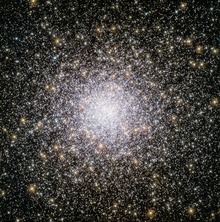NGC 362
| NGC 362 | |
|---|---|
 False-color image of NGC 362 by GALEX; | |
| Observation data | |
| Class | III[1] |
| Constellation | Tucana |
| Right ascension | 01h 03m 14.26s[2] |
| Declination | −70° 50′ 55.6″[2] |
| Distance | 29.29 ± 0.20 kly (8.98 ± 0.06 kpc)[3] |
| Apparent magnitude (V) | 6.4 |
| Apparent dimensions (V) | 12.9′ |
| Physical characteristics | |
| Metallicity | = –1.09[4] dex |
| Estimated age | 11.0 ± 0.6 Gyr[3] |
| Other designations | Melotte 4 |
NGC 362 (also known as Caldwell 104) is a globular cluster located in the constellation Tucana in the Southern Hemisphere, slightly north of the Small Magellanic Cloud, to which it is completely unrelated. It was discovered on August 1, 1826, by James Dunlop.[5] It is visible to the naked eye in dark skies, and is an impressive sight in a telescope, although it is somewhat overshadowed by its larger and brighter neighbour 47 Tucanae.[6]

The stars of NGC 362 have an average metallicity higher than the stars in most globulars. This implies that NGC 362 is a relatively young globular cluster.[6] It also has an overabundance of binary stars, and an exceptionally tight core 13 light-years in diameter.[6] The orbit of NGC 362 is highly eccentric, taking it to within 3,260 light-years of the Galactic Center.[6]
See also
References
- ^ Shapley, Harlow; Sawyer, Helen B. (August 1927), "A Classification of Globular Clusters", Harvard College Observatory Bulletin, 849 (849): 11–14, Bibcode:1927BHarO.849...11S.
- ^ a b Goldsbury, Ryan; et al. (December 2010), "The ACS Survey of Galactic Globular Clusters. X. New Determinations of Centers for 65 Clusters", The Astronomical Journal, 140 (6): 1830–1837, arXiv:1008.2755, Bibcode:2010AJ....140.1830G, doi:10.1088/0004-6256/140/6/1830, S2CID 119183070.
- ^ a b Gontcharov, George A.; Khovritchev, Maxim Yu; Mosenkov, Aleksandr V.; Il'In, Vladimir B.; Marchuk, Alexander A.; Savchenko, Sergey S.; Smirnov, Anton A.; Usachev, Pavel A.; Poliakov, Denis M. (2021). "Isochrone fitting of Galactic globular clusters – III. NGC 288, NGC 362, and NGC 6218 (M12)". Monthly Notices of the Royal Astronomical Society. 508 (2): 2688–2705. arXiv:2109.13115. doi:10.1093/mnras/stab2756.
- ^ Forbes, Duncan A.; Bridges, Terry (May 2010), "Accreted versus in situ Milky Way globular clusters", Monthly Notices of the Royal Astronomical Society, 404 (3): 1203–1214, arXiv:1001.4289, Bibcode:2010MNRAS.404.1203F, doi:10.1111/j.1365-2966.2010.16373.x, S2CID 51825384.
- ^ "NGC 362". SEDS. Retrieved 28 June 2015.
- ^ a b c d O'Meara, Stephen James (2003). Deep Sky Companions: The Caldwell Objects. Cambridge University Press. pp. 409–412. ISBN 9780521827966.
External links
 Media related to NGC 362 at Wikimedia Commons
Media related to NGC 362 at Wikimedia Commons- "NGC 362". SIMBAD. Centre de données astronomiques de Strasbourg.
- Vu, Linda (20 June 2007). "Galaxy Evolution Explorer Spies Band of Stars". NASA. Archived from the original on 7 April 2013. Retrieved 28 June 2015.

![{\displaystyle {\begin{smallmatrix}\left[{\ce {Fe}}/{\ce {H}}\right]\end{smallmatrix}}}](https://wikimedia.org/api/rest_v1/media/math/render/svg/4c0821bd80891e071c08e7c7ee8e022baedf522c)